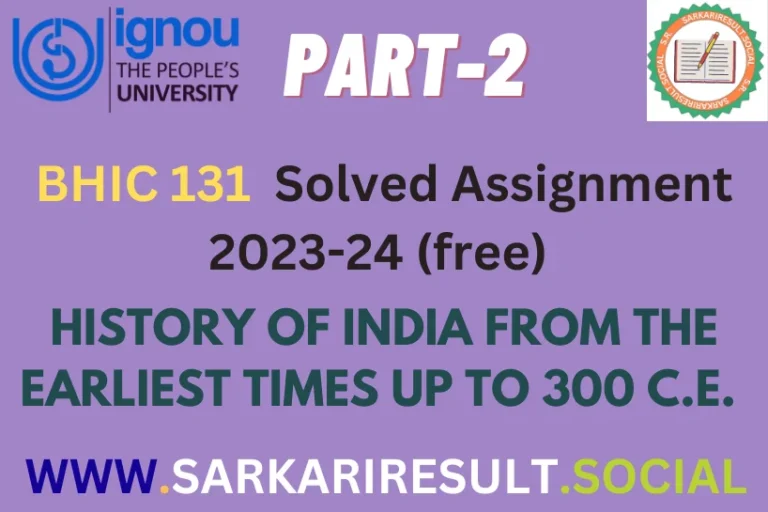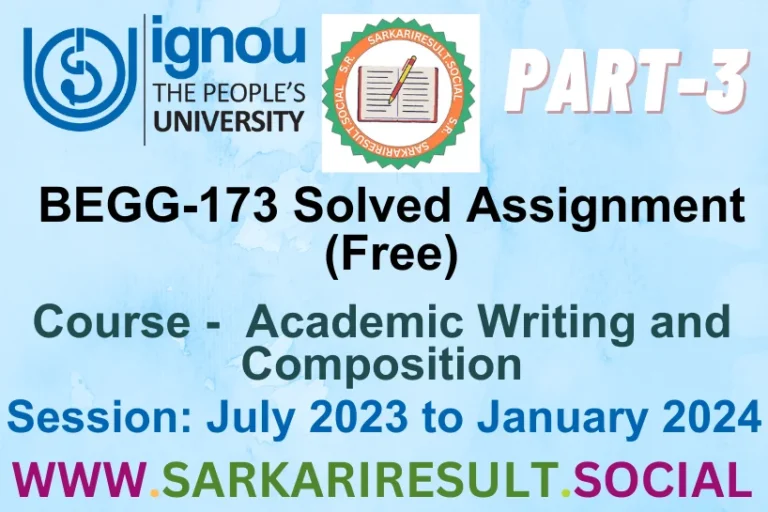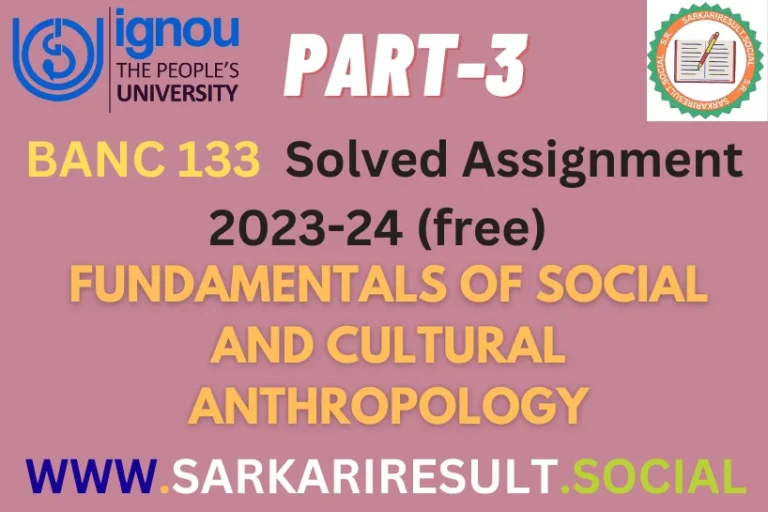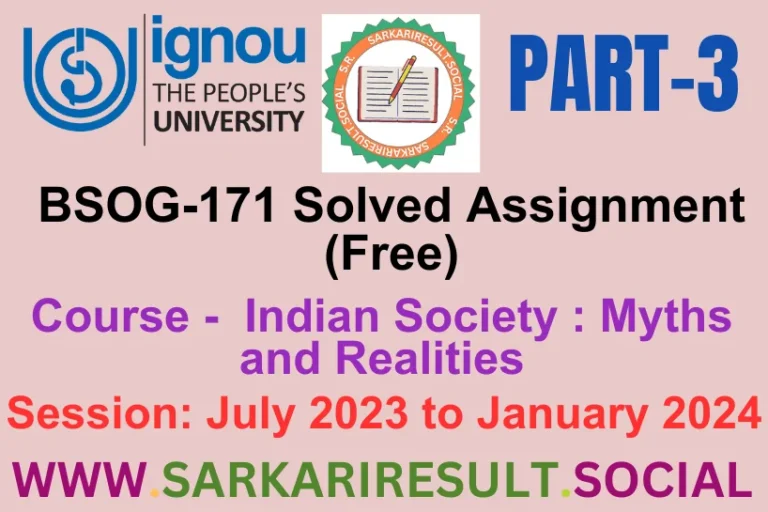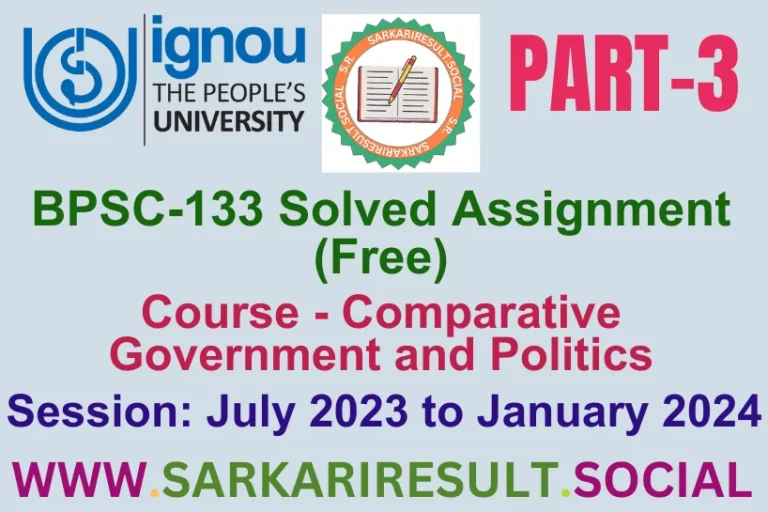BPSC 132 SOLVED IGNOU ASSIGNMENT FREE PART 1

Welcome to the BPSC 132 SOLVED IGNOU ASSIGNMENT FREE PART 1 TMA. Assignment – I features two comprehensive questions. In about 500 words each, discuss the essential features of the Indian Constitution and explain the functions and jurisdiction of the Supreme Court and High Courts. Our concise responses provide a clear and efficient path for comprehending these critical aspects of Indian government and politics, ensuring a successful completion of your assignments.

Answer the following in about 500 words each. Each question carries 20 mark.
Q.1 Discuss the essential features of the Indian Constitution.
Ans. The Indian Constitution, adopted on January 26, 1950, is a comprehensive document that lays down the framework for the governance of the Republic of India. It reflects the aspirations of a diverse and pluralistic society, aiming to secure justice, liberty, equality, and fraternity for its citizens. Here are the essential features of the Indian Constitution:
1. Preamble:
– The Preamble serves as the guiding spirit of the Constitution, outlining its objectives, including justice, liberty, equality, and fraternity. It reflects the vision of the framers and sets the tone for the rest of the document.
2. Federal Structure with Unitary Features:
– India has a federal structure with powers divided between the central government and states. However, during emergencies, the Constitution allows for a temporary shift toward a more unitary system to meet the exigencies.
3. Parliamentary System:
– India follows a parliamentary system of government where the executive is drawn from the legislature. The President is the ceremonial head, and the Prime Minister is the head of government.
4. Fundamental Rights:
– The Constitution guarantees Fundamental Rights to Indian citizens, including the right to equality, freedom of speech, right to life, and protection against discrimination. These rights are justiciable and can be enforced by the courts.
5. Directive Principles of State Policy:
– The Directive Principles provide guidelines to the government for socio-economic welfare. While not enforceable in court, they are considered fundamental in the governance of the country.
6. Fundamental Duties:
– Added through the 42nd Amendment, Fundamental Duties emphasize the moral obligations of citizens toward the nation. These duties are not legally enforceable but act as ethical imperatives.
7. Independent Judiciary:
– The Constitution establishes an independent judiciary to safeguard citizens’ rights and ensure justice. The Supreme Court is the highest judicial authority with the power of judicial review.
8. Universal Adult Franchise:
– India adopts the principle of universal adult suffrage, granting voting rights to all citizens above the age of 18. This promotes democratic participation and inclusivity.
9. Secularism:
– India is a secular state, ensuring equal treatment of all religions. The Constitution guarantees freedom of religion and prohibits discrimination on religious grounds.
10. Reservation Policies:
– To address historical socio-economic disparities, the Constitution provides for reservations in education, employment, and legislative representation for marginalized communities.
11. Amendment Procedure:
– The Constitution allows for amendments to adapt to changing circumstances. While it upholds the basic structure doctrine, amendments can be made by a special majority of Parliament.
12. Rule of Law:
– The Constitution establishes the supremacy of the law. All citizens, including government officials, are subject to the law, ensuring justice and fairness.
13. Election Commission:
– The Constitution establishes an independent Election Commission responsible for conducting free and fair elections at various levels.
14. Integrated Judiciary:
– The judiciary in India is integrated, with a hierarchy of courts from the Supreme Court at the top to various High Courts and subordinate courts at the state and district levels.
15. Local Self-Government:
– The Constitution provides for local self-government institutions, emphasizing decentralization and empowering local bodies for effective governance.
16. Single Citizenship:
– Unlike federal countries with dual citizenship (national and state), India has a single citizenship for all citizens of the country.
In conclusion, the Indian Constitution is a living document that adapts to the evolving needs of its diverse population. Its essential features reflect a commitment to democracy, social justice, and the protection of individual liberties.
Q.2 Explain the functions and jurisdiction of the Supreme Court and High Courts.
Ans. The Supreme Court and High Courts in India constitute the apex judicial system, ensuring justice and interpreting the Constitution. Each has specific functions and jurisdiction.
Supreme Court:
Functions:
1. Guardian of the Constitution:
– The Supreme Court is the ultimate interpreter and guardian of the Constitution. It ensures that laws do not violate constitutional provisions.
2. Adjudication of Disputes:
– It has original jurisdiction in disputes between the central government and one or more states or between states.
3. Appellate Jurisdiction:
– The Supreme Court hears appeals from High Courts and, in certain cases, directly from lower courts. It can reverse or affirm judgments.
4. Protection of Fundamental Rights:
– The Supreme Court protects the Fundamental Rights of citizens through writs like habeas corpus, mandamus, prohibition, quo warranto, and certiorari.
5. Advisory Jurisdiction:
– The President can seek the Court’s opinion on constitutional matters, although this is not binding.
6. Review and Curative Jurisdiction:
– The Supreme Court can review its own judgments and has curative jurisdiction to correct any miscarriage of justice.
7. Settlement of Interstate Disputes:
– It has jurisdiction to adjudicate disputes between states and between the central government and states.
8. Guardian of Federal Structure:
– The Court safeguards the federal structure of the country, ensuring a balance between the center and states.
Jurisdiction:
1. Original Jurisdiction:
– In cases involving disputes between the center and states or between states, the Supreme Court has original jurisdiction.
2. Appellate Jurisdiction:
– It hears appeals against decisions of High Courts and has appellate jurisdiction over various tribunals.
3. Writ Jurisdiction:
– The Supreme Court can issue writs for the enforcement of Fundamental Rights.
4. Advisory Jurisdiction:
– It provides advisory opinions to the President on constitutional matters.
5. Exclusive Jurisdiction:
– Matters related to the enforcement of Fundamental Rights fall exclusively under the Supreme Court’s jurisdiction.
High Courts:
Functions:
1. Original Jurisdiction:
– High Courts have original jurisdiction in matters involving revenue, probate, matrimonial disputes, and admiralty.
2. Appellate Jurisdiction:
– They hear appeals from subordinate courts and tribunals within their jurisdiction.
3. Writ Jurisdiction:
– High Courts can issue writs like habeas corpus, mandamus, prohibition, quo warranto, and certiorari for the enforcement of Fundamental Rights.
4. Guardian of Fundamental Rights:
– High Courts play a crucial role in protecting the Fundamental Rights of citizens.
5. Supervision over Subordinate Courts:
– They have administrative and judicial control over the subordinate courts within their territorial jurisdiction.
6. Appointment of District Judges:
– High Courts have the authority to appoint district judges in the state judiciary.
7. Settlement of Disputes:
– High Courts play a role in resolving disputes related to land revenue, tenancy, and local government elections.
Jurisdiction:
1. Original Jurisdiction:
– High Courts have original jurisdiction in cases involving major crimes, civil matters of significant value, and issues related to the interpretation of the Constitution.
2. Appellate Jurisdiction:
– They hear appeals from subordinate courts and tribunals.
3. Writ Jurisdiction:
– High Courts can issue writs for the enforcement of Fundamental Rights.
4. Administrative Jurisdiction:
– They have administrative control over the lower judiciary in their respective states.
5. Advisory Jurisdiction:
– Like the Supreme Court, High Courts can provide advisory opinions to the Governor on constitutional matters.
In summary, the Supreme Court and High Courts serve as the pillars of India’s judicial system, ensuring access to justice, protecting constitutional values, and maintaining the rule of law. Their functions and jurisdiction are intricately designed to cater to diverse legal needs and challenges at both the national and state levels.
Also See This: BPSC 132 SOLVED IGNOU ASSIGNMENT FREE PART 2

